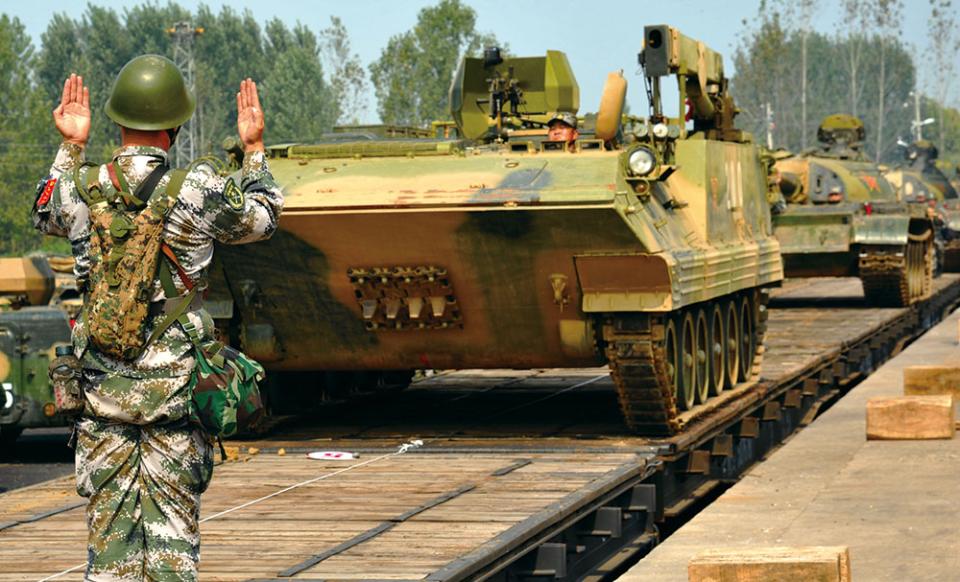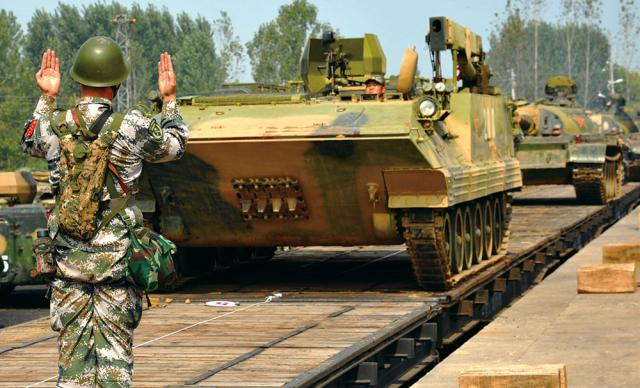At the closing meeting of the bimonthly session of the National People’s Congress (NPC) Standing Committee held in September 2016, China’s top legislative body passed a new law on national defense transport.
Initially launched in April 2013, shortly after the new generation of leadership under President Xi Jinping assumed power, the bill is widely considered to be an integral part of China’s ongoing military reforms, officially unveiled in November 2015, which aim to achieve “breakthrough” growth of China’s military capabilities by 2020. Unlike their reluctance to elaborate on China’s military ambitions in the past, this time Chinese officials are forthright in spelling out the bill’s mission.
At a press conference held following the passing of the new law, Huang Weiye, a senior officer in the Logistical Support Department of the Central Military Commission (CMC), China’s highest military command authority, told the media that the bill is aimed at promoting China’s “strategic projection capabilities.” Through articulating the roles and responsibilities of various sectors, while at the same time setting up an effective regulatory mechanism, the bill will help China establish a “modern strategic projection system,” said Huang.
Force Projection
For much of the last decade, establishing a credible power projection capability has been a key focus of China’s military establishment. China’s military, the People’s Liberation Army (PLA), launched its first aircraft carrier, the Liaoning, a refurbished Soviet-era carrier purchased from Ukraine, and is also building a new homegrown carrier that analysts believe could be ready as early as 2020. The Chinese navy has already received four Type 071 amphibious transport docks, which increase China’s ability to launch amphibious landings, conduct humanitarian aid and evacuate civilians. In July, the Chinese air force officially put the Y20, a domestically-developed heavy transport military aircraft, into service, which greatly increased China’s power projection capability.
Besides the progress made in improving military equipment, long-distance force projection has increasingly become a major focus of the PLA’s military exercises in recent years. In 2007, for “Peace Mission 2007,” a joint military drill held in Russia by member states of the Shanghai Cooperation Organization, China sent 1,600 personnel and several thousand tons of equipment from a military base in northwestern China to Chelyabinsk, Russia. According to China’s State media, the whole trip involved a 10,300-kilometer railway ride and a 2,700- kilometer airlift, making it the most far-reaching force projection operation in the history of the PLA by some distance.
More recently, the PLA has conducted an increasing number of joint drills involving different branches of the armed forces and various forms of transport. For example, in the “Stride 2016 – Zhurihe A” military drill launched in northern China on July 15, 2016, the PLA’s 1st Army Corps sent a reinforced brigade of 5,000 troops and their heavy equipment over road, rail, and by air to a military base more than 2,000 kilometers away in Inner Mongolia within 11 days.
The drill was the first major military exercise the PLA had held since the establishment of five new “theater commands” created under the keynote military reforms announced earlier this year.
An expert from the PLA Academy of Military Sciences, who asked to be quoted anonymously because he was not authorized to speak to the media, told NewsChina that the drill largely reflected China’s overall power projection capability. He said the country is now capable of sending a reinforced tank brigade to a location 2,000 kilometers away in 10 days.
While the PLA still lags far behind the US military in term of power projection on a global scale, it has established a formidable force projection capability to respond to any emergencies in China’s remote border regions.
Unified System
Although the PLA has established specialized heavy transport troops, its power projection capability is rather limited when acting on its own. More often than not, the military needs the cooperation of local governments and the civilian sector to meet its transport demands.
The new law is aimed at addressing this. China’s military experts have long argued that the PLA faces some institutional barriers to further strengthening its power projection capability. For example, there is no unified national defense transport system to facilitate cooperation between local governments and the military.
Although agencies designed to facilitate defense transport are already set up in each province, region and municipality, these agencies often fall under different departments in different provinces. In some provinces, the agency falls under the transportation department, and in others, it falls under the development and reform commission.
Moreover, almost all of these agencies are understaffed. According to a Journal of the Military Transportation University report released in August, the provincial-level agencies have just 37 percent of the staff they need. Even more seriously, there were previously no regulations on how the costs incurred in the military transportation process should be covered. All of these factors could cause major problems for the military’s cross-region maneuvers.
According to the new bill, the State Council and the CMC will be tasked with establishing and overseeing a national defense transport network with a designated budget. A consultation mechanism will also be established between local governments and military departments to disseminate and discuss information regarding transport plans and demands. According to Zhao Keshi, head of the Logistical Support Department of the CMC, the bill adopts an approach of integrating military and civilian resources in establishing a national unified system.
After decades of booming infrastructure development, China has established a much more advanced land, sea and air transportation system, including massive railway, highway and airport networks that have great potential to boost the PLA’s power projection capability within the country’s borders.
In outlining its vision, the bill stresses that the government should follow the strategy of civilian-military integration by “optimizing the distribution of resources between the civilian and military sectors” and “balancing the need for economic and defense development” in order to promote the capabilities of the defense transport system in handling its work in “routine, emergency and wartime situations.”
The approach is in line with the strategy of China’s overall military reforms, as President Xi has repeatedly called for deepening cooperation between the civilian and military sectors. In a Politburo meeting held in March, Xi said that civilian-military integration will be a top priority in national strategy in the coming years.
Experiments in civilian-military integration for power projection have been carried out in recent drills. According to a report in the PLA Daily, in a drill held in April, the PLA Army’s 40th Army Corps commissioned a local transportation company to transport tanks to a designated location. Thanks to the new bill, it is expected that the private sector will play a bigger role in China’s military operations in the future.
Overseas Operations
Along with the emphasis on civilian-military integration, another key focus of the bill is that it extends the scope of China’s overseas military operations. In articulating the roles of various sectors in the defense transport system, the bill stipulates that Chinese companies and organizations operating overseas are obliged to supply and assist Chinese vehicles, vessels and airplanes involved in China’s overseas operations of “international disaster relief, maritime escort, and other military activities that aim to defend China’s national interests.” The bill makes it clear that the expenses incurred on these missions should be borne by the military at a price comparable to market rates.
Although this is the only clause that mentions China’s overseas military operations in the new bill, many consider it an indicator that China is becoming increasingly explicit and outspoken about protecting its growing and vulnerable overseas interests.
In the past few years, China has conducted a number of landmark overseas operations. In 2011, China sent the frigate Zhoushan and several Il-76 transport aircraft to war-torn Syria. A total of 35,000 Chinese nationals were cleared out of the country, mostly via ship and passenger planes.
In April 2015, China conducted another evacuation operation in Yemen. Unlike the 2011 operation in Syria, which only involved a token force from the PLA, China sent a special navy force this time with two frigates, the Weifang and Linyi, to the Yemeni port of Aden. The special force took control of part of the port and evacuated 613 Chinese nationals and 279 foreigners to the Chinese warships, which transported them to Djibouti.
In March 2016, China signed an agreement with Djibouti to establish a “logistics and resupply center” for Chinese ships in the country. In the meantime, China has also become more assertive in articulating its overseas interests. In the 2015 white paper on China’s national defense, for example, “safeguarding the security of China’s overseas interests” was listed for the first time as one of the major “strategic tasks” of the PLA.
As China continues to push forward its ambitious military reform and strives to build up its power projection capabilities, there is no doubt that the country is determined to enter the international stage as a fully-fledged global power.

 Old Version
Old Version
